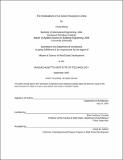The implications of US senior housing to China
Author(s)
Wang, Yong, S.M. Massachusetts Institute of Technology
DownloadFull printable version (892.7Kb)
Alternative title
Implications of United States senior housing to China
Other Contributors
Massachusetts Institute of Technology. Dept. of Architecture.
Advisor
Brian Anthony Ciochetti.
Terms of use
Metadata
Show full item recordAbstract
In 2005, China had approximately 144 million people aged over 60, accounting for 11 percent of the whole population. In 2010, this population will reach 1,700 million and consist of 12.78% of the total population. It is also estimated that less than 200,000 seniors live in those not-for-profit, non-government senior housing centers. This is 0.14% of total population of 144 million people aged over 60 in 2005. If 3% of seniors may choose to live in a senior housing environment, it will create an investment market of RMB90 billion to RMB100 billion. However, in China, much foreign capital has been invested in real estate products such as office, residential, retail, logistics, and hotel. Little capital has been deployed in senior housing. The for-profit senior housing market is emerging as local developers have started to catch up the needs of the elderly in China. None of them are sophisticated enough compared to senior housing owners and operators in US. In China, the increased number of middle-class, and the rapid social and cultural changes of traditional elderly care have demonstrated that the elderly' great needs for better quality of retirement life and experiences. The existing for-profit senior housing market in US and both the for-profit and not-for-profit markets in China are discussed. Opportunities and challenges to US developers/ investors as well as the implications of US senior housing to China are analyzed. Several strategies are also proposed for potential US developers and/ or investors to seriously look into this niche market in China now.
Description
Thesis (S.M. in Real Estate Development)--Massachusetts Institute of Technology, Dept. of Architecture, 2007. This electronic version was submitted by the student author. The certified thesis is available in the Institute Archives and Special Collections. Includes bibliographical references (p. 67-71).
Date issued
2007Department
Massachusetts Institute of Technology. Department of ArchitecturePublisher
Massachusetts Institute of Technology
Keywords
Architecture.